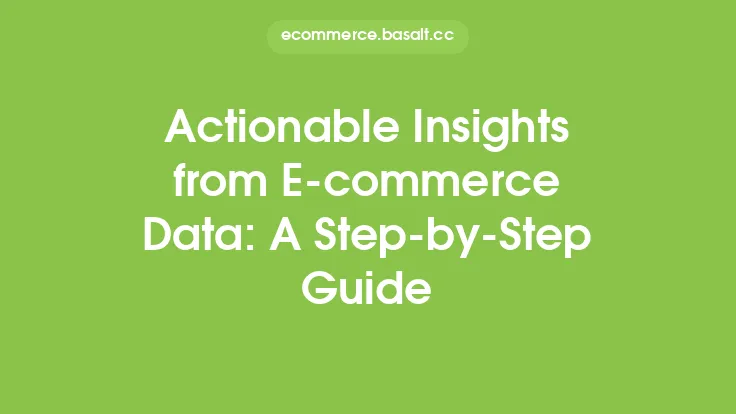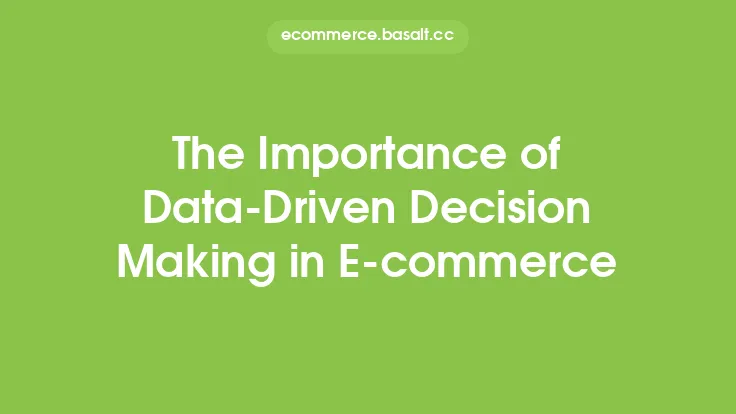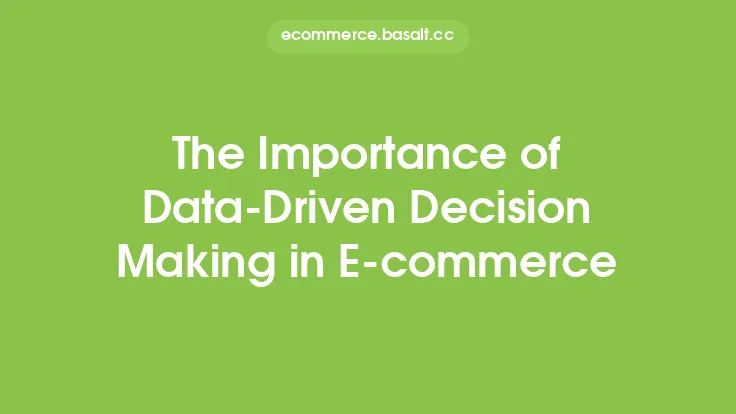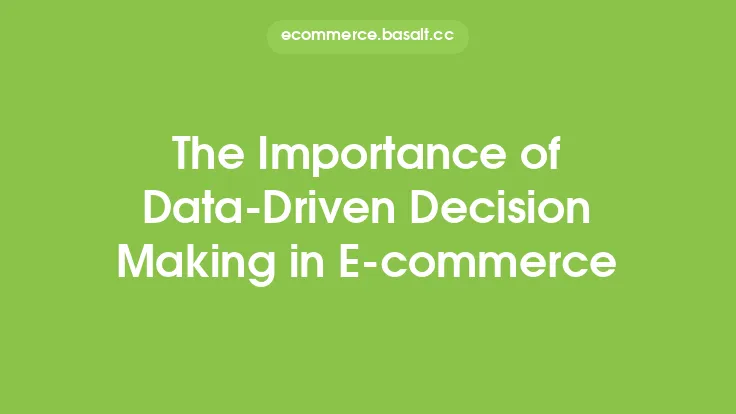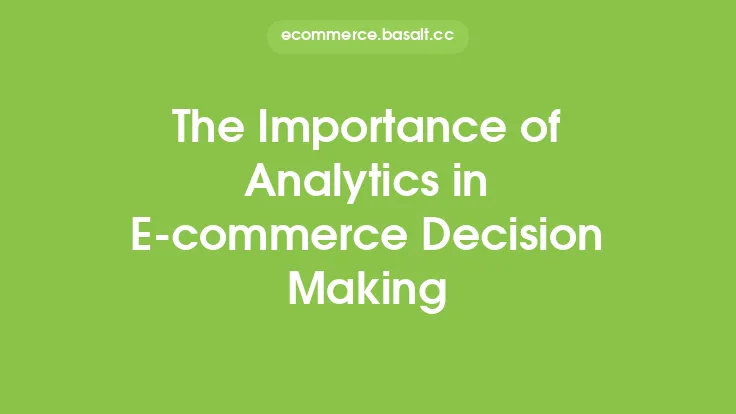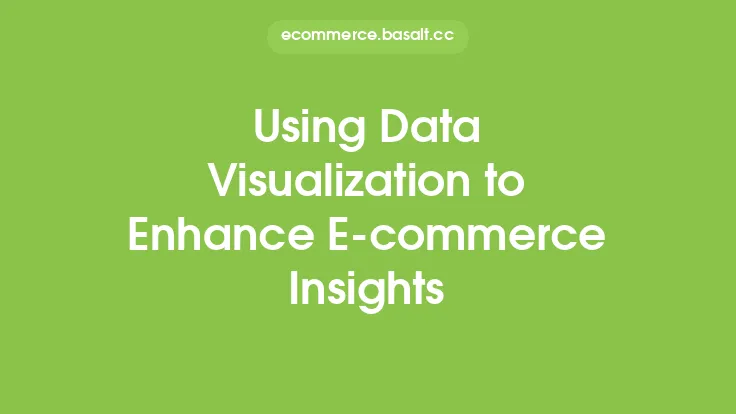In the world of e-commerce, data is king. With the vast amount of information available, it can be overwhelming to sift through and make sense of it all. However, by leveraging actionable e-commerce insights, businesses can make informed decisions that drive growth, improve customer satisfaction, and increase revenue. The key to unlocking these insights lies in the ability to collect, analyze, and interpret data from various sources.
Understanding E-commerce Data
E-commerce data comes in many forms, including website traffic, sales, customer behavior, and product performance. This data can be collected from various sources, such as website analytics tools, customer relationship management (CRM) software, and social media platforms. To gain actionable insights, it's essential to understand the different types of data and how they relate to each other. For instance, website traffic data can provide information on the number of visitors, page views, and bounce rates, while sales data can reveal trends in product demand, customer purchasing behavior, and revenue growth.
Identifying Key Performance Indicators (KPIs)
To make sense of the vast amount of e-commerce data, businesses need to identify key performance indicators (KPIs) that align with their goals and objectives. KPIs are measurable values that demonstrate how effectively a company is achieving its targets. Common e-commerce KPIs include conversion rates, average order value, customer lifetime value, and retention rates. By tracking these KPIs, businesses can monitor their progress, identify areas for improvement, and make data-driven decisions to optimize their operations.
Analyzing Customer Behavior
Customer behavior is a critical aspect of e-commerce analytics. By analyzing customer data, businesses can gain insights into their target audience's preferences, needs, and pain points. This information can be used to create personalized marketing campaigns, improve customer experience, and increase loyalty. For example, analyzing customer purchase history and browsing behavior can help businesses identify trends and patterns, such as frequently bought together products or abandoned cart items. This information can be used to create targeted promotions, recommend products, and improve the overall shopping experience.
Leveraging Segmentation and Clustering
Segmentation and clustering are powerful techniques used in e-commerce analytics to group customers based on their behavior, demographics, and preferences. By segmenting customers, businesses can create targeted marketing campaigns, tailor their product offerings, and improve customer satisfaction. Clustering, on the other hand, involves grouping customers based on their behavior, such as purchase history, browsing behavior, and search queries. This information can be used to identify high-value customer segments, predict future behavior, and create personalized experiences.
Using Machine Learning and Predictive Analytics
Machine learning and predictive analytics are advanced techniques used in e-commerce analytics to forecast future trends and behavior. By analyzing historical data and using machine learning algorithms, businesses can predict customer churn, forecast demand, and identify new opportunities. For instance, predictive analytics can be used to forecast sales, identify seasonal trends, and optimize inventory levels. Machine learning can also be used to personalize product recommendations, improve customer service, and detect fraud.
Creating a Data-Driven Culture
To get the most out of e-commerce analytics, businesses need to create a data-driven culture that encourages collaboration, experimentation, and continuous learning. This involves providing employees with the necessary tools, training, and resources to collect, analyze, and interpret data. It also requires a mindset shift, where data is seen as a strategic asset that drives decision-making. By fostering a data-driven culture, businesses can ensure that everyone is working towards the same goals, and that data is used to inform every aspect of the organization.
Implementing E-commerce Analytics Tools
There are many e-commerce analytics tools available, ranging from basic website analytics tools to advanced predictive analytics platforms. When selecting an analytics tool, businesses should consider their specific needs, goals, and resources. Some popular e-commerce analytics tools include Google Analytics, Adobe Analytics, and Salesforce Commerce Cloud. These tools provide a range of features, such as data visualization, segmentation, and predictive analytics, to help businesses gain actionable insights and make data-driven decisions.
Best Practices for E-commerce Analytics
To get the most out of e-commerce analytics, businesses should follow best practices, such as regularly reviewing and updating their analytics tools, ensuring data quality and accuracy, and using data visualization to communicate insights. It's also essential to set clear goals and objectives, track key performance indicators, and use data to inform every aspect of the organization. Additionally, businesses should stay up-to-date with the latest trends and technologies, such as artificial intelligence, machine learning, and the Internet of Things (IoT), to stay ahead of the competition.
Overcoming Common Challenges
Despite the many benefits of e-commerce analytics, there are common challenges that businesses face, such as data overload, lack of resources, and difficulty in interpreting complex data. To overcome these challenges, businesses should prioritize their goals and objectives, focus on key performance indicators, and use data visualization to simplify complex data. It's also essential to invest in employee training and development, ensure data quality and accuracy, and use automation and machine learning to streamline analytics processes.
Future of E-commerce Analytics
The future of e-commerce analytics is exciting and rapidly evolving. With the rise of artificial intelligence, machine learning, and the Internet of Things (IoT), businesses will have access to even more powerful tools and techniques to gain actionable insights and drive growth. The use of voice commerce, augmented reality, and virtual reality will also become more prevalent, providing new opportunities for businesses to engage with customers and create immersive experiences. As the e-commerce landscape continues to evolve, businesses that invest in e-commerce analytics will be well-positioned to stay ahead of the competition and achieve long-term success.
